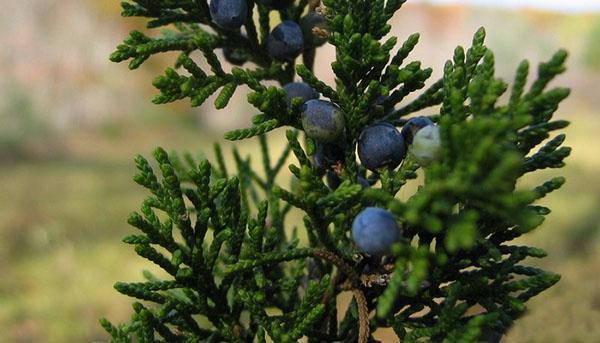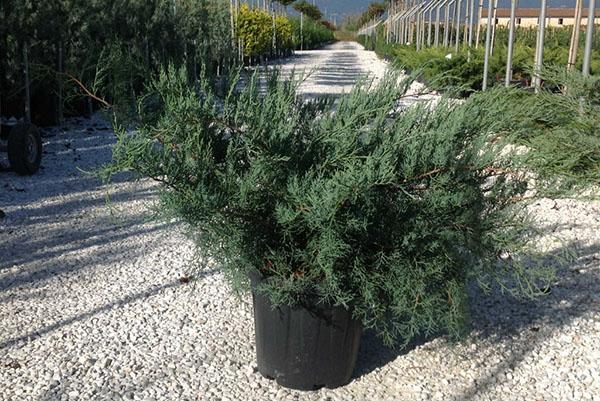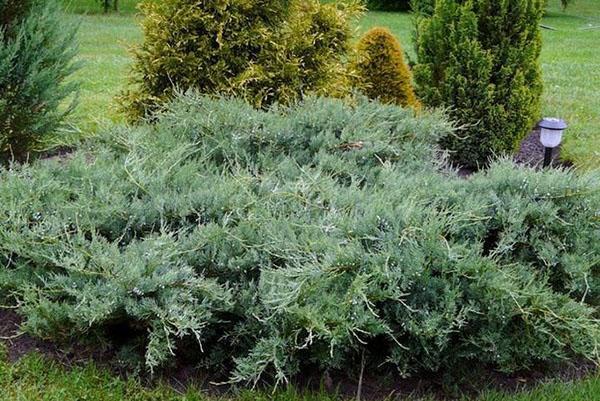Description of the Virginian juniper and its most popular varieties.
 Juniper Virginia is an evergreen, mostly monoecious plant belonging to the Cypress family. Depending on the specific variety, it can be a horizontal shrub or a vertical tree (more about horizontal junipers). The maximum life span reaches 500 years, and the maximum plant height is 30 m.
Juniper Virginia is an evergreen, mostly monoecious plant belonging to the Cypress family. Depending on the specific variety, it can be a horizontal shrub or a vertical tree (more about horizontal junipers). The maximum life span reaches 500 years, and the maximum plant height is 30 m.
Upon reaching 40 years of life, trees of the Virginia juniper species begin to lose their decorative appeal.
The fruits of plants of this species are cones with different colors, but often dark blue. The berries continue to stick to the branches until the onset of frost, which gives the juniper additional decorative qualities during the fruiting period. The root system of the Virginia juniper is highly developed with lateral branches, which makes these plants independent to gusts of wind. In its natural environment, juniper can be found on rocky terrain, occasionally in wetlands in North America.
There are approximately 70 varieties of juniper. They all differ:
- by form;
- by height;
- the color of the needles;
- and other characteristics.
Features of planting and care

Juniper reproduces in 3 ways:
- using seeds;
- vaccinations;
- by cuttings.
Grafting is used exclusively for rare varieties. Gardeners, on the other hand, give their preference to method 3 - cuttings, but there is a slight nuance here. Without proper care and special measures, only half of all planted cuttings take root, but when using the stimulation of survival, the positive result can be increased up to 80%.
It is better to choose a sunny place for planting with drained soil (use ordinary broken brick as drainage). Stagnant water can lead to fungal infections.
Most varieties of this plant tolerate drought and frost well, but some varieties need additional spraying with water and tying branches before winter comes.
Planting is best done in the spring or fall. Due to the developed root system, planting (transplanting) must be carried out with a dug out lump of earth, without shaking off the bush. The depth of the planting pit should be about 70 cm, and the distance between the seedlings, depending on the variety, is 0.5-2 m. When planting a plant, the neck of the rhizome should be left above the ground, this will allow the plant to receive the required amount of oxygen.
Juniperus virginiana care consists of:
- regular weeding;
- loosening the soil around the plant;
- humidification;
- mulching soil.
Next, we will consider the most popular varieties and a detailed description of the Virginia juniper.
Gray Оwl
 Juniper Virginia Gray Oul is a low-growing evergreen shrub with a spreading crown. Branches are large and spread horizontally. An adult bush reaches up to 3 m in height and about 7 m in diameter. It is characterized by slow growth, so during the year it adds up to 10 cm in height and 20 cm in width. The needles have a gray-blue or gray-green tint.The fruits are blue-gray berries.
Juniper Virginia Gray Oul is a low-growing evergreen shrub with a spreading crown. Branches are large and spread horizontally. An adult bush reaches up to 3 m in height and about 7 m in diameter. It is characterized by slow growth, so during the year it adds up to 10 cm in height and 20 cm in width. The needles have a gray-blue or gray-green tint.The fruits are blue-gray berries.
When planting, it is better to choose a sunny location with well-drained, well-moistened soil. In connection with its dimensions, a distance of 1.5 m must be observed between the seedlings.
Frost and drought tolerant, but additional spraying is desirable during particularly hot summers.
To create a beautiful, dense crown, constant pruning of branches is necessary.
Hetz
 Juniper Virginia Khetz is an upright shrub with a spreading shape. The height of an adult plant is 1-2 m with a width of 3 m. The plant is a fast-growing plant. The needles have a pleasant gray-blue color, which can turn brown when frost sets in. Fruits are dark blue berries.
Juniper Virginia Khetz is an upright shrub with a spreading shape. The height of an adult plant is 1-2 m with a width of 3 m. The plant is a fast-growing plant. The needles have a pleasant gray-blue color, which can turn brown when frost sets in. Fruits are dark blue berries.
For planting, it is better to choose a place in the sun or in partial shade; when planting in the shade, it loses the brightness of the color. Absolutely not whimsical in the choice of soil.
It is advisable not to allow the soil to be compacted.
Cold and drought resistant. It tolerates prolonged drought and heat well. In winter, branches can break off under the weight of snow, and therefore it is recommended to tie the branches and install a frame before the arrival of winter.
A distinctive feature of this variety is its strong aroma and abundant fruiting.
Glauca
 Juniper Virginsky Glauka is a vertical shrub whose crown has a columnar or narrow-pointed shape. It reaches a height of up to 6 m, and in a girth of 2-2.2 m. Differs in rapid growth, so in a year it can add up to 20 cm. The needles have a blue-green tint, which turns bronze when cold comes. Fruits - cones berries of a white-gray shade up to 0.6 cm in diameter. During fruiting, the branches are abundantly strewn with berries (cones).
Juniper Virginsky Glauka is a vertical shrub whose crown has a columnar or narrow-pointed shape. It reaches a height of up to 6 m, and in a girth of 2-2.2 m. Differs in rapid growth, so in a year it can add up to 20 cm. The needles have a blue-green tint, which turns bronze when cold comes. Fruits - cones berries of a white-gray shade up to 0.6 cm in diameter. During fruiting, the branches are abundantly strewn with berries (cones).
A sunny area will be a good landing site; when planting in partial shade, the shrub turns pale, the color becomes less expressive. Unpretentious to the soil and its composition.
It is advisable not to allow moisture to linger.
Like all virgin junipers, it is drought and frost-resistant. Glauka perfectly tolerates crown cutting. In this case, the formed form remains for a long time.
Skyrocket
 Juniper Virginia Skyrocket is an upright tree with a conical crown. It can reach up to 8 m in height and up to 1 m in diameter. Refers to fast-growing species, annually adds 20 cm in height and up to 5 cm in volume. The needles are colored bluish-green or gray-green. Fruits - berries of a round shape with a bluish color.
Juniper Virginia Skyrocket is an upright tree with a conical crown. It can reach up to 8 m in height and up to 1 m in diameter. Refers to fast-growing species, annually adds 20 cm in height and up to 5 cm in volume. The needles are colored bluish-green or gray-green. Fruits - berries of a round shape with a bluish color.
Sunlight is required for planting and availability is good drainage.
This variety of Virginia juniper will die in the shade.
Frost and drought resistant, well tolerates air pollution.
Moonglow
 Juniper Virginia Munglou is a shrub with a conical crown. Its height reaches 4 m, and the diameter is 1-1.5 m. Fast-growing, during the year it can add 10-15 cm. The needles have a bright bluish-blue color. Fruits - cones berries of a round shape with a dark blue color.
Juniper Virginia Munglou is a shrub with a conical crown. Its height reaches 4 m, and the diameter is 1-1.5 m. Fast-growing, during the year it can add 10-15 cm. The needles have a bright bluish-blue color. Fruits - cones berries of a round shape with a dark blue color.
Loves sunny terrain, can tolerate light partial shade. It tolerates frost and drought well, is not picky about the soil.
Blue arrow
 Juniper Virginia Blue Arrow is an upright shrub shaped like an arrow shot. The maximum height is 2-2.5 m, and the diameter is 0.5-0.7 m. Fast-growing, adds about 15 cm in height and up to 5 cm in girth per year. The needles have a remarkable bright blue color. The fruits are blue cones.
Juniper Virginia Blue Arrow is an upright shrub shaped like an arrow shot. The maximum height is 2-2.5 m, and the diameter is 0.5-0.7 m. Fast-growing, adds about 15 cm in height and up to 5 cm in girth per year. The needles have a remarkable bright blue color. The fruits are blue cones.
Of all the varieties presented, this Virginian juniper is the most demanding. When planting, one must take into account its exceptional light-requiring and the need for protection from the wind.
It is frost-resistant, but during the period of heavy snowfalls, it is necessary to shake off the branches to avoid breaking them. It is drought-resistant, but additional spraying is necessary in case of prolonged heat. It is better to select nutritious soil, with good drainage, to avoid soil compaction.
A distinctive feature of this variety is that the branches begin to grow from the very bottom. Doesn't need additional trimming.